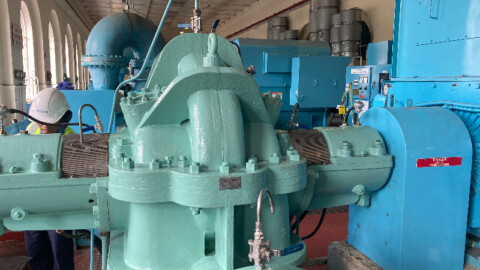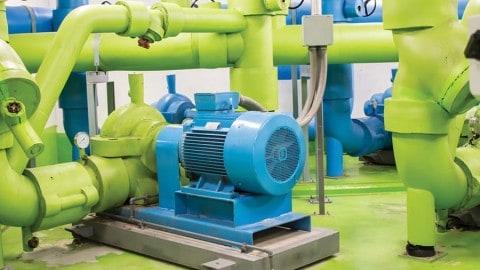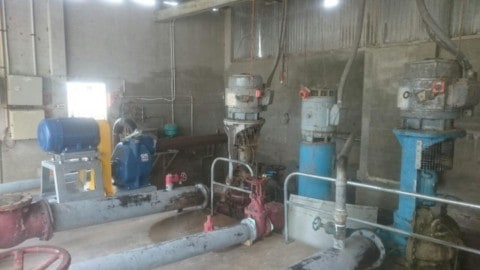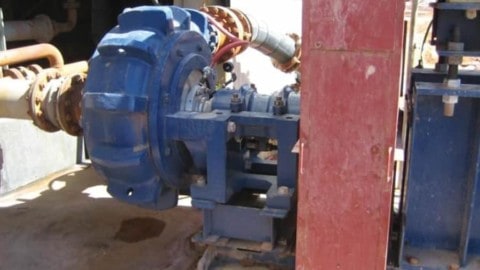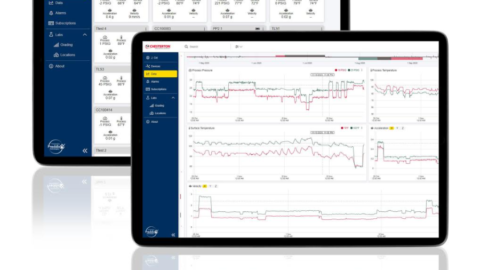By Lauren DeLorenzo, Journalist, Pump Industry magazine
There’s no way to sugarcoat it – finding the right pump for chocolate manufacturing is a tricky balance. Chocolate pumps need to delicately handle high viscosity mediums, maintain a consistent temperature and uphold hygiene standards. Luckily, you don’t need a golden ticket to uncover the secrets of how, where and why pumps are used in the chocolate manufacturing process.
Through milling, blending, refining, smoothing, tempering, depositing, enrobing and packaging, pumps play a critical role in bringing chocolate to the masses. The global chocolate industry is projected to grow at an annual rate of 4.5 per cent between 2022 and 2027, with increasing demand for dark chocolates, as well as sugarfree, vegan and gluten free products, fuelling growth.
To accommodate this projected growth, the efficiency and quality of chocolate pumps will become increasingly important. But as one of the most difficult food substances to pump, chocolate poses a significant challenge to pump suppliers and chocolate manufacturers alike.
Here, we look at how pumps are used in chocolate production, common chocolate pump pitfalls and the essential qualities that pumps need to create this mood-boosting treat.
The chocolate-making process
While chocolate manufacturing processes can differ depending on the type of cocoa beans used, most use comparable machines and follow a similar procedure.
1. Winnowing
First, cocoa beans, which have been fermented and dried, will be refined by removing the outer shell (a process called winnowing) so that the nib is left over. In ancient times, this was done by throwing the grain into the air and letting the wind blow away the outer shell.
Modern manufacturers use a winnowing machine to crack the shells and break up the cocoa bean into smaller pieces (cocoa nibs). The machine vibrates, separating the nibs from the shells and removing any other impurities so that the nibs can be sorted by size and processed.
2. Refining
Nibs are then put into a refining machine, which produces heat and grinds the nibs into even smaller pieces at very high speeds. The high amount of fat in the cocoa melts down, and it is processed into a high viscosity substance called cocoa mass.
Depending on the type of chocolate, different ingredients can be added at this stage. For milk chocolate, the cocoa is mixed with cocoa butter, sugar, cocoa liquor, powdered milk and other flavouring ingredients. Dark and white chocolate have different ingredients, and flavours for specialised chocolates are added in at this stage.
3. Conching
Conching is the stage of bulk chocolate production where finishing touches are added to the texture and flavour through various mixing and grinding processes.
First, the moisture level of the cocoa is reduced, and volatile acids, like acetic acid, short-chain fatty acids and aldehydes are removed. This is done by heating, mixing and aerating the cocoa.
Then the cocoa is reshaped and run through machines to flatten and aerate the particles. This is where the particle size of the added ingredients (milk powder and sugar) is refined to make them even more uniform and to coat them more evenly with cocoa butter.
This gives chocolate its viscosity, flow and textural properties, and determines how smoothly the chocolate will melt in the mouth. The technology used in this stage is extremely important, as consistent temperatures need to be maintained depending on the type of chocolate being made.
Some dark chocolates can be conched up to 90°C. However, milk chocolates usually need to be kept at a temperature of around 50°C to prevent caramelisation of the product, which can cause unpleasant lumps in the chocolate and clog the pumps.
Finally, tempering makes chocolate smooth and glossy, and aligns polymorphic crystals in the vat so that they all harden at the same
temperature. This stage involves mixing, cooling and shaping the chocolate under precise conditions.
The challenges of chocolate pumps
Pumps are used in almost every stage of chocolate production, and as the product changes shape, size and texture, its pumping requirements change too. This makes it a particularly challenging food to transfer, with delicate temperature, hygiene, and shear-sensitive requirements. Here are some of the most significant considerations for pumping chocolate.
Maintaining temperature
Not only do different types of chocolate need to be kept at different temperatures, but this temperature must be maintained to keep the cocoa moving through the pumps and to ensure that it doesn’t burn and affect the taste.
High temperatures can cause chocolate to congeal or caramelise, which causes lumps. As more and more chocolate congeals, friction increases in the pump, leading to even more heat and an increased chance of blockages and damage.
Constant monitoring of the chocolate pump temperature can help mitigate this, and pumps need to be resistant to overheating.
Handling abrasive ingredients
On the other hand, as chocolate cools, it can solidify in the pump during a shutdown period. If the pump is restarted while hardened chocolate is coating the equipment, this can cause major damage.
Instead, it is critical that the chocolate is warmed and melted before the pump is restarted. This needs to be done delicately, as direct heat can burn the chocolate and ruin the taste.
One solution is to choose a pump with a single or double cover heating jacket feature, which allows for hot water or steam to run through the pump. Here, the heated water or steam runs through cavities within the pump that do not come into direct contact with the chocolate.
This can be placed around the face or body of the pump. Because of its higher thermal conductivity, iron pumps melt chocolate more quickly than stainless steel pumps.
Viscosity requirements
The viscosity of chocolate can fluctuate drastically, presenting unique challenges for pump manufacturers. At room temperature, chocolate can reach as high as 50,000 centipoise. Most manufacturers pump chocolate above 50°C, which brings the viscosity back to around 25,000 centipoise.
As a high viscosity medium, slower pump speeds are required to allow the chocolate to pass through the suction of the pump. Pumps need to create sufficient vacuum to bring liquid chocolate into the suction side of the pump and to force it out of the pump against system pressure.
Chocolate requires pumps with low discharge pressure in order to handle cocoa butter, sugar and other solid, abrasive ingredients. Keeping a pump below 300rpm is a general guideline for chocolate pumping requirements.
Hygiene requirements
Chocolate pumps need to adhere to hygiene requirements, as this is a product for human consumption. This means that pumps will need to comply with industry standards, and be made from appropriate materials. Pumps need to be easy to clean to avoid cross contamination between different kinds of chocolates.
Pumps that are fitted with clean in place (CIP) ports can ensure that equipment is easy to dismantle and clean. Hygienic pumps should be used when incorporating dairy products into chocolate (like when creating milk chocolate), as there is a higher contamination hazard.
Shear sensitivity
Chocolate is extremely shear sensitive – meaning that if it is pumped too quickly, the cocoa butter and other ingredients can begin to separate, leading to burned chocolate and increased chance of a blockage. Pumps which operate at or below 101psi are recommended for chocolate production, as higher pressures can make ingredients start to separate.
Which pumps work best?
Due to chocolate’s shear sensitivity and high viscosity, centrifugal pumps are generally inefficient in the manufacturing process, as they run at high speeds and have trouble handling high viscosity.
Positive displacement pumps, however, increase in flow rate and efficiency with higher viscosity. These pumps have chambers that expand to draw liquid in, and then contract to force liquid out.
Positive displacement pumps are also a good choice as they operate at low speeds, typically less than 300rpm. It is less likely that fresh liquid will reach the area between the idler bushing and pin when pumps operate at higher speeds.
Because the flow of positive displacement pumps is directly proportional to speed, variable speed drives are able to provide a simple manual or automatic control of speed. This is particularly useful in chocolate manufacturing, where controlling speed to match the load can help optimise efficiency and reduce the chance of ruining the chocolate through high speeds.
Positive displacement pumps with check valves and acceleration forces, such as diaphragm pumps, generally create shear, making them unsuitable for chocolate. The preferred choices for chocolate manufacturing are gear pumps, rotary lobe or circumferential piston pumps.
Gear pumps are the most costeffective option, and are easier to maintain due to their single shaft seal. However, lobe or circumferential piston pumps, which have two shaft seals, can handle chocolates that contain larger solid ingredients such as raisins, small candies or nuts.
Another consideration is minimising the shear created through discharge pressure as the chocolate passes through pump clearances. It is generally recommended to keep the discharge pressure less than 100psi.
One solution is to avoid piping system restrictions which could create unnecessary backpressure.
Which materials are best?
There are a wide range of material options for chocolate pumps, with cast iron and stainless steel being the most common. Handling high viscosity chocolate means that pump components should be constructed of strong materials, such as steel rotors.
Cast iron is the most common external material for pumps in chocolate manufacturing, because it is simple to remove any metal particles contaminating the chocolate with magnetic separators. Cast iron gear pumps are the best choice for chocolates with low potential for bacterial growth.
Corrosion of these materials is not usually an issue, because chocolate pumps are not cleaned with harmful chemicals. Chocolate is not a good promoter of bacteria or fungi growth, and so equipment can be cleaned sparingly.
Pump seals for chocolate manufacturing
Chocolate can leak and harden, and so it is even more important that pumps are well-sealed to prevent leaks. Chocolate can often leak from the pump shaft. The most common and simple shaft seal solution is a packed gland with food-grade braided packing in the stuffing box.
The packing should be loose enough to allow some chocolate to leak out (up to a rate of one drop per minute), so it can cool and lubricate the packing, creating a puddle around the base of the pump (or in a collection tray).
Packing inevitably leads to some product loss, and while generally reliable, there is also the risk that operators may tighten packing glands too much to minimise leakage, which can result in scored shafts, burned chocolate and pumps locking up.
Additionally, packing may not always meet the hygiene requirements needed, and an alternative solution is using dynamic O-ring seals on the shaft. These seals are extremely tolerant, can handle high viscosity material and are low cost.
A food grease barrier can be used to keep chocolate in the pump and out of the bracket, where there is the risk of it disrupting a pump. Unlike packing, they do not require re-tensioning, and can handle very high pressures.
Mechanical seals can also be used, but have a higher risk of needing replacement. This is because the chocolate at the seal face can damage the seal if it is not completely melted before start up.
Often, mechanical seals are located behind the pump rotor with a lip seal at the stuffing box. Lip seals have a maximum working pressure of four bar, and are only recommended for relatively non-abrasive chocolates. Chocolate can crystallise on the seals and cause further damage.

More general guidelines
General guidelines for pumping chocolate include adjusting clearances and not exceeding a maximum rotor rim speed of 250. Internal pressure relief valves should be avoided, as they are prime areas for chocolate to build up and clog the pump. Instead, external valves and other over-pressure protection measures can be used.
Fitting pumps with drilled idlers (drilling staggered holes through idler gear and bushing) can help prevent overheating and buildup of chocolate in the pumps. This allows chocolate to reach the area between the pin and idler more easily. Specialised pumps can apply cocoa butter to the idler pin for external lubrication and better flow.








